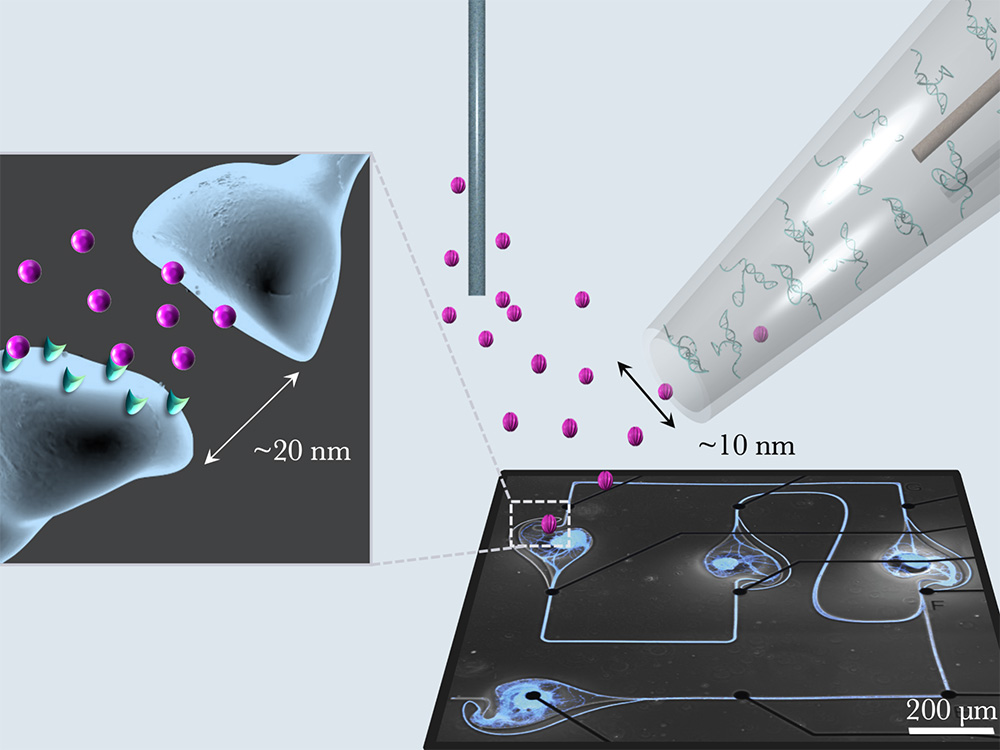
"Think of the DNA strand as a tiny, tiny, tiny baseball glove that is specifically designed to detect and catch a “molecular ball” of serotonin or dopamine,” says Nakatsuka. (Illustration: Nako Nakatsuka)
The tool itself is glass pipette with a 10-nanometer tip, so small that it is invisible to the naked eye. By combining DNA sequences and two electrodes, the chemical sensor allows researchers to detect and to measure neurochemicals as they travel through the nanoscale opening of the glass pipette. Nakatsuka aims to further develop her biosensing technology laying the groundwork for future applications in preventative medicine, as well as treatment strategies for brain diseases.
Ikigai - finding passion and purpose
“My life has been a series of lucky coincidences,” she says, but when Nako Nakatsuka recounts her life it is clearly more about passion than coincidence. Often combining her passions for
art, sports, and science
with purpose, she illustrated the children’s book, “A is for Atom, ABCs for Aspiring Chemists.” Her passion spans generations from starring in “Kids Teach Science Experiments to a Real Scientist” episodes to inspiring her now super fit 89-year-old grandmother to take up a gym membership. From her perspective, “The sky is the limit when you help someone believe that they can do something.”
For Nako Nakatsuka finding her sense of purpose in life or “ikigai” was a matter of perseverance. “Things are always going to be hard at some point, but if I had allowed myself to be consumed by those thoughts, I wouldn’t have been able to move forward…it is sheer grit that gets us through the tough times.” Born in Osaka, Japan and raised in Tokyo, Nakatsuka describes her family life as traditionally Japanese, except for the unconventional decision of her mother to enrol her in the all-girls’, English-speaking, International School of the Sacred Heart. Typically, Japanese children attend a non-denominational, co-educational school system, with a focus on Japanese language, culture, and history. She reflects, “I think being in an international and all-girls’ school was super helpful. I never had to worry about the socio-cultural gender dynamics that exist in co-ed schools. Instead of worrying about self-image, I was able to focus on my studies and athletic goals. I felt accepted for who I was even though I was a bit of a nerd.”
A twist of fate
Nakatsuka found strong female role models throughout her life. At Fordham University in New York City, Professor Ipsita Banerjee challenged her beyond the Bachelor’s degree curriculum with a hands-on research experience working in a bio-nanotechnology lab focused on tissue engineering. There, while still an undergraduate, she earned shared authorship on her first peer reviewed scientific papers. At the University of California, Los Angeles (UCLA) she was mentored by Professor Anne Andrews who trained her to tackle visionary scientific problems while honing her skills in communicating science.
Perhaps it was a twist of fate, however, that led to the impromptu UCLA campus tour that she gave to a visiting professor who described his research at ETH Zurich as one of the best experiences of his scientific career. Nakatsuka confesses that at the time she had never heard of ETH Zurich but was inspired to apply. Janos Vörös invited her to interview and supported her in the highly competitive application for an ETH Zurich Postdoctoral Fellowship. The fellowship made her first two years at ETH Zurich possible. She recounts, “It was during that first visit to ETH Zurich for the interview that I fell in love with the Laboratory of Biosensors and Bioelectronics. I remember feeling that “This is it!”